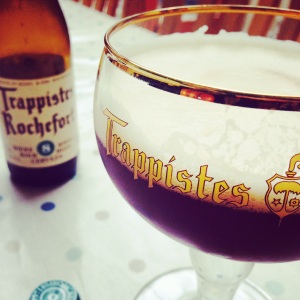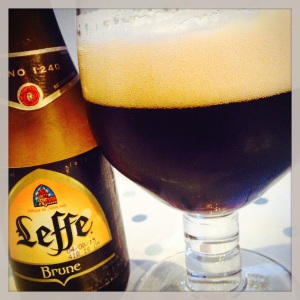ABInbev, makers of Stella Artois make the claim that their beer is so special, so worthy, that it should only be served in a chalice. But for a lagered beer, a chalice is all wrong: too wide mouthed to funnel the aroma, too broad and round to allow the fine head of a lager form and retain. No, a chalice should be saved for those most reverential of beers; beers truly of the highest worth; those from a heavenly source, the Trappist beers.
 I mulled on this when I finally got my Trappistes Rochefort chalice from The Beer Emporium in Sandbach, my home town. I’d been meaning to get over there for a while but business got in the way and eventually my parents took delivery. The chalice? A thing of pure beauty, curvaceous, broad rimmed, delicately branded: could the beer match it? And a chalice indeed, fitting enough to be put on a high alter for worship.
I mulled on this when I finally got my Trappistes Rochefort chalice from The Beer Emporium in Sandbach, my home town. I’d been meaning to get over there for a while but business got in the way and eventually my parents took delivery. The chalice? A thing of pure beauty, curvaceous, broad rimmed, delicately branded: could the beer match it? And a chalice indeed, fitting enough to be put on a high alter for worship.
Trappistes Rochefort beers are held in high regard. I bought two bottles; one of Rochefort 6, the other of Rochefort 8; beers that I knew by reputation but had only tried the stronger 10 before. I couldn’t wait. The Rochefort beers don’t use what has become the ‘standard’ Trappist and abbey terminology: a Dubbel (normally dark & sweet) and a Tripel (typically pale, hopper and strong). More simply, more archaically their beers are defined in Belgian degrees: 6, 8 and 10. All are strong: the 6 at 7.5% ABV, the 10 at 11.3% ABV. All are dark. All have a sweeter character.
 The 8 smells nutty and earthy. It pours a deep burnished brown; brown like a Tudor dresser, with a creamy head carrying a mark of an espresso swirl from the yeast. The lacing is profuse yet of a gossamer thinness – a thing of wonder, draping the side of the glass as you sip. To drink there is a sizzle of carbonation from the refermentation, which despite the darker, heavier appearance gives this beer a wild, refreshing spritziness. It is complex and malty with a yeasty, warming alcohol; it is earthy not spicy. It is, ironically, a diabolically good beer. The 6 is equally complex, equally intriguing. Whilst not light in alcohol it is moderately lighter in colour with a redder tinge. Like the 8, it is an earthy beer: flavours matching Nature’s colour palate of greens and browns, of falling leaves and New England, yet with dried fruit flavours: raisins, currants and very much the Old World. Is this really the Monks’ session beer? It is humble, but humble in its majesty.
The 8 smells nutty and earthy. It pours a deep burnished brown; brown like a Tudor dresser, with a creamy head carrying a mark of an espresso swirl from the yeast. The lacing is profuse yet of a gossamer thinness – a thing of wonder, draping the side of the glass as you sip. To drink there is a sizzle of carbonation from the refermentation, which despite the darker, heavier appearance gives this beer a wild, refreshing spritziness. It is complex and malty with a yeasty, warming alcohol; it is earthy not spicy. It is, ironically, a diabolically good beer. The 6 is equally complex, equally intriguing. Whilst not light in alcohol it is moderately lighter in colour with a redder tinge. Like the 8, it is an earthy beer: flavours matching Nature’s colour palate of greens and browns, of falling leaves and New England, yet with dried fruit flavours: raisins, currants and very much the Old World. Is this really the Monks’ session beer? It is humble, but humble in its majesty.
 Serendipitously, friends bought some beer over when we had a barbecue a few nights ago; bottles they had bought on a Calais booze cruise. Yes, there were some Euro lagers but also, nestling in the corner of the box were some 25cl bottles of a more religious kind: Leffe. The comparison had to be made. If Rochefort beers are relatively hard to come by; steadfastly uncommercial, then Leffe is at the other end of the spectrum. The Leffe abbey beers (brewed on behalf of the monks of the Norbertine abbey, Notre Dame de Leffe by A B Inbev) are widely available, even promoted occasionally. Brewed by the world’s largest brewer, distributed by a sales and marketing machine, it would be easy to assume that they don’t merit mention, don’t warrant comparison. True, neither have the alcoholic punch of the Rochefort beers; neither enjoy the same complexity; neither brewed with the same heavenly single-mindedness and passion. Yet these are interesting, tasty beers. The Blonde is 6.6%, with an orangey-bronze colour and a spicier nose than those of Rochefort. It is a fruity beer, that easily forms a fulsome head and drinks rather like a spicy wit beer, only with less citrus and even a slight barnyard, Brettonamyces character (which is coincidental). Good, but I preferred the sweeter Bruin, at 6.5%. This is a deep brown beer, presumably with dark candi sugar in the mash; it is more layered; and to drink suggests Christmas cake with spiced apple. A savouring beer; but a devilishly drinkable one at that. If any of ABInbev’s beers should be served in a chalice, then this would be the one.
Serendipitously, friends bought some beer over when we had a barbecue a few nights ago; bottles they had bought on a Calais booze cruise. Yes, there were some Euro lagers but also, nestling in the corner of the box were some 25cl bottles of a more religious kind: Leffe. The comparison had to be made. If Rochefort beers are relatively hard to come by; steadfastly uncommercial, then Leffe is at the other end of the spectrum. The Leffe abbey beers (brewed on behalf of the monks of the Norbertine abbey, Notre Dame de Leffe by A B Inbev) are widely available, even promoted occasionally. Brewed by the world’s largest brewer, distributed by a sales and marketing machine, it would be easy to assume that they don’t merit mention, don’t warrant comparison. True, neither have the alcoholic punch of the Rochefort beers; neither enjoy the same complexity; neither brewed with the same heavenly single-mindedness and passion. Yet these are interesting, tasty beers. The Blonde is 6.6%, with an orangey-bronze colour and a spicier nose than those of Rochefort. It is a fruity beer, that easily forms a fulsome head and drinks rather like a spicy wit beer, only with less citrus and even a slight barnyard, Brettonamyces character (which is coincidental). Good, but I preferred the sweeter Bruin, at 6.5%. This is a deep brown beer, presumably with dark candi sugar in the mash; it is more layered; and to drink suggests Christmas cake with spiced apple. A savouring beer; but a devilishly drinkable one at that. If any of ABInbev’s beers should be served in a chalice, then this would be the one.
© Beer Tinted Spectacles, 2014
